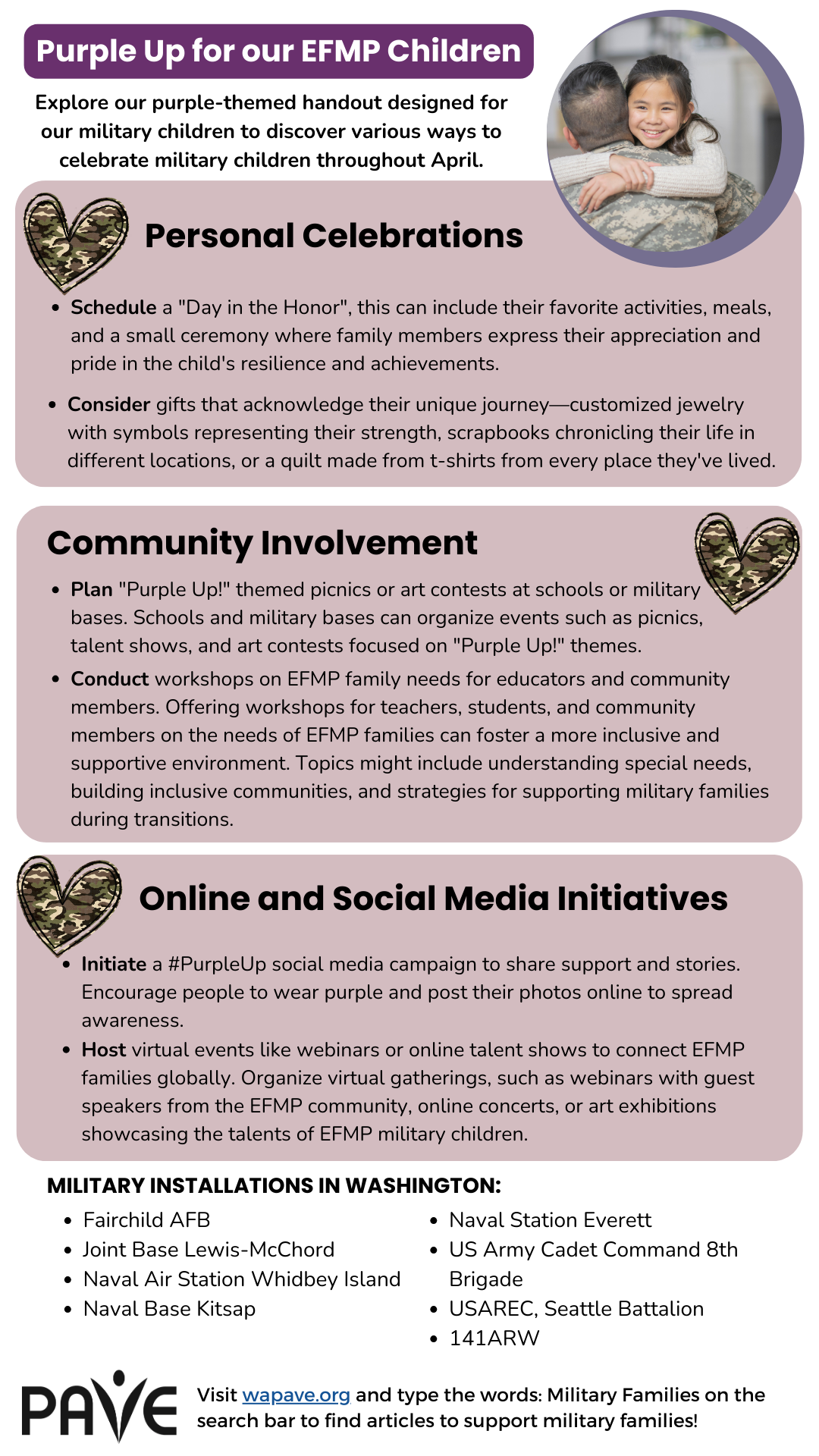April, the Month of the Military Child, celebrates military-connected children and youth. They show an ability to adapt in the face of unique challenges. They make sacrifices while their service members protect our nation’s safety.
A Brief Overview
- Month of the Military Child (MOMC) is a chance to show your support for military-connected children and youth.
- Purple symbolizes military children from all branches of the U.S. Armed Forces.
- Wear purple (Purple Up!) during April to show your support for military children, especially on April 15th, National Purple Up Day.
- PAVE has created downloadable materials for military children and an infographic with ideas to help you celebrate military children with special needs, available at the end of this article in multiple languages.
Purple is the official color of the military child. It’s a combination of all the colors of the U.S. Armed Forces: Air Force, Navy, and Coast Guard blues, Army green, and Marine Corps red. Programs and activities that are similar across all branches of service are called “purple.”
Wear purple to show your support and appreciation for what they do!
History of Month of the Military Child
In 1986, former Secretary of Defense Caspar Weinberger created the first Month of the Military Child. This annual April tradition became a nationally recognized celebration of military children’s resiliency when faced with stressful situations, such as frequent moves, long separations from deployed family members, living in foreign countries, and adapting to different schools.
In 2011, the University of New Hampshire Cooperative Extension Military Youth and Family Program began Purple Up! For Military Kids. It’s a specific day to wear purple as visible support for military-connected children during Month of the Military Child. States, local governments, and Department of Defense programs celebrate Purple Up days on various dates during April. National Purple Up Day is April 15th.
Military Children in Our Communities
A Department of Defense 2023 Demographics Report* showed 1,511,167 military children (including up to age 20 or 22 if enrolled as full-time students) in Active Duty and Selected Reserve families across the world. Washington State has 37,668 military-connected children and youth between birth and eighteen years of age. Military-connected children are neighbors. Many of them live and go to school near military installations. If their service member is in the National Guard or other reserves, they may live anywhere!
Military children come from many different backgrounds. Being in the military is different for each family. Differences are as typical of military life as similar experiences.
Author Lynn K. Hall said, “The defining word for the military family is change; change is what their lives are about.” On average, military families move every two to three years. Military children change schools an average of six to nine times between kindergarten and their high school graduation. Despite frequent changes, military children show remarkable resiliency like the dandelion plant.
Dandelions are the official flower of the military child. They take root and bloom wherever they are planted. Dandelion seeds fly on the wind to destinations all over the globe. Dandelions symbolize happiness, joy, perseverance, endurance, and hope – traits shown by military children.
Show Your Support for Military Children
Thank military children for their sacrifices and recognize their courage during Month of the Military Child.
Families and individuals can:
- Organize or take a group picture with everyone wearing purple to share on social media with the hashtags #PurpleUp or #MOMC.
- Use any of the ideas and resources below for businesses and schools.
- Look up WA State Veterans organizations on the internet and social media. They will often post local events supporting and celebrating military-connected children.
- Military installations often post MOMC events on their social media pages. You may be able to go, volunteer, or share on your pages.
Businesses can add a temporary banner or image to their website or social media pages. Find images and text at the Military Interstate Children’s Compact Commission’s (MIC3) website.
Parent-School associations and school staff can celebrate military-connected students by:
- Wearing a purple ribbon and inviting military children to share their experiences within their comfort levels.
- Encouraging other students to “purple up” at a specified team practice or event.
- Mentioning Purple Up Day in the morning announcements, school message boards, and bulletin boards throughout the campus.
- Using a world map in the classroom to pinpoint where students have traveled, including highly mobile military students.
- Sending a letter home to all parents inviting them to provide a baby picture for a hallway or corridor “Guess Who” display of military children.
You might use suggestions from the Military Child Education Coalition and Military Interstate Children’s Compact Commission (MIC3).
Go to a STOMP (Specialized Training of Military Parents) workshop or webinar to learn more about supporting military children in the classroom, community, and medical settings. Share about STOMP, a program of PAVE, as a resource to educate and empower military parents of children with special needs.
Resources for Military Children and Youth:
STOMP has developed printable worksheets in honor of the Month of the Military Child. These worksheets are available in the most common written languages spoken by multilingual military families, including Spanish, German, Tagalog, and French.**
- Finding Your Tribe: a questionnaire to help children make friends and develop community after a move.
Download in Spanish / Descargar “Encontrando Tu Tribu” en español
Download in German / “Deine Gruppe Finden” auf Deutsch herunterladen
Download in Tagalog / I-download ang “Hanapin ang Iyong Tribo” sa Tagalog
Download in French / Télécharger “Trouver Votre Tribu” en français
- PCS Bingo: a tool to help a relocating family get to know their new community, one adventure at a time!
Download in Spanish / Descargar “Bingo PCS” en español
Download in German / “PCS Bingo” auf Deutsch herunterladen
Download in Tagalog / I-download ang “PCS Bingo” sa Tagalog
Download in French / Télécharger “Bingo PCS” en français
- Friendships Across the Miles: activities for maintaining close friendships wherever military life takes you.
Download in Spanish / Descargar “Amistad a Través de las Millas” en español
Download in German / “Freundschaft Über die Meilen” auf Deutsch herunterladen
Download in Tagalog / I-download ang “Pagkakaibigan sa Kabila ng mga Milya” sa Tagalog
Download in French / Télécharger “Amitié à Travers les Miles” en français
- Sound Your Cadence Call: a worksheet for developing an individualized, confidence-boosting cadence.
Download in Spanish / Descargar “Llama Tu Cadencia” en español
Download in German / “Rufe Deinen Takt” auf Deutsch herunterladen
Download in Tagalog / I-download ang “Tunog ng Iyong Tawag ng Kadensiya” sa Tagalog
Download in French / Télécharger “Sonner Votre Appel de Cadence” en français
- Social Stories: this social story helps military children understand and cope with their parent’s absence due to military duties by providing emotional support and practical strategies for managing their feelings.
Download in Spanish / Descargar “Soy un Niño Soldado.” en español
Download in German / “Ich bin ein Militärkind” auf Deutsch herunterladen
Download in Tagalog / I-download ang “Ako ay Bata Militar” sa Tagalog
Download in French / Télécharger “Je suis un enfant de militaire” en français
Learn More
- The Air Force School Liaison Program provides 50 Ways to Celebrate Month of the Military Child.
- Military Child Education Coalition and Military Interstate Children’s Compact Commission (MIC3) release updated toolkits for the Month of the Military Child every year.
- The Defense-State Liaison Office provides state policymakers with expert insights on priorities affecting military families, and advocates for policy change to improve their quality of life.
- Sesame Street for Military Families offers resources and support to help military families and their children navigate the unique challenges of military life, such as deployments, relocations, and transitions.
*Published by the Department of Defense and Office of the Deputy Assistant Secretary of Defense for Military Community and Family Policy (ODASD (MC&FP)).
**Based on the 2021 Blue Star Families Military Lifestyle Survey, from the Department of Applied Research at Blue Star Families in collaboration with the D’Aniello Institute of Veterans and Military Families, Syracuse University (IVMF).


